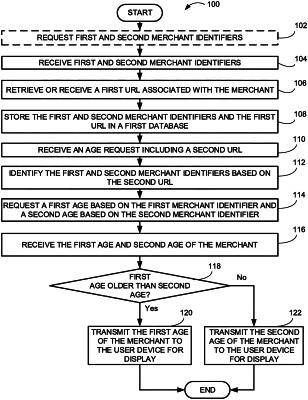| CPC G06Q 30/0609 (2013.01) [G06F 16/9566 (2019.01); G06F 40/205 (2020.01); G08B 21/182 (2013.01); H04L 63/102 (2013.01)] | 8 Claims |

|
1. A system, comprising:
one or more processors; and
memory in communication with the one or more processors and storing instructions that, when executed by the one or more processors, are configured to cause the system to:
request a first merchant identifier associated with a merchant from a first payment processor database and a second merchant identifier associated with the merchant from a second payment processor database;
receive the first merchant identifier associated with the merchant from the first payment processor database and the second merchant identifier associated with the merchant form the second payment processor database;
retrieve or receive a first uniform resource locator (URL) associated with the merchant;
store the first merchant identifier, the second merchant identifier, and the first URL in a first database to generate a first data entry for the merchant;
in response to a web browser extension via a user device detecting that a user is preparing to make an online purchase, receive an age request for the merchant from the user device, wherein the age request comprises a second URL;
identify the first merchant identifier and the second merchant identifier in the first database based on the second URL;
request a first age of the merchant from the first payment processor database based on the first merchant identifier and a second age of the merchant from the second payment processor database based on the second merchant identifier;
receive the first age of the merchant from the first payment processor database and the second age of the merchant from the second payment processor database;
determine that the first age of the merchant is older than the second age of the merchant based on transaction timestamps associated with the first and second merchant identifiers; and
transmit the first age of the merchant to the user device for display.
|